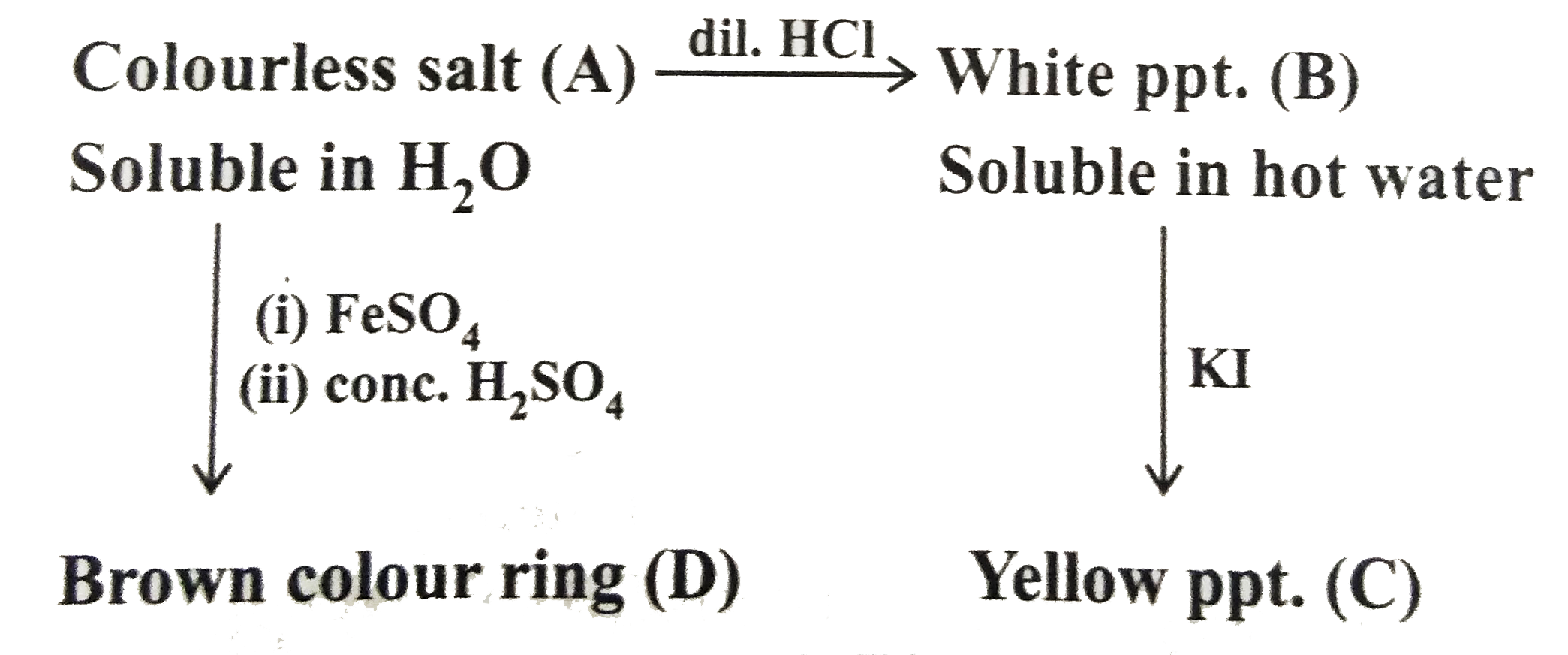Colourless salt (A)dil.HCI−−−−→ White ppt. (B)

Iidentify (A),(B),(C ) and (D)
(A) Pb(NO3)2 (B) PbCI2
(C ) PbI2 (D) [Fe(H2O)3NO]2+
Topper's Solved these Questions
- QUALITATIVE INORGANIC SALT ANALYSISBOOK - CENGAGE CHEMISTRYCHAPTER - QUALITATIVE INORGANIC SALT ANALYSISEXERCISE - Solved Example
11 Videos
- QUALITATIVE INORGANIC SALT ANALYSISBOOK - CENGAGE CHEMISTRYCHAPTER - QUALITATIVE INORGANIC SALT ANALYSISEXERCISE - Exercises (Linked Comprehension)
68 Videos
- P-BLOCK GROUP 18 ELEMENTS - THE INERT GASESBOOK - CENGAGE CHEMISTRYCHAPTER - P-BLOCK GROUP 18 ELEMENTS - THE INERT GASESEXERCISE - Ex 5.1 (Objective)
14 Videos
- REDUCTION AND OXIDATION REACTION OF ORGANIC COMPOUNDSBOOK - CENGAGE CHEMISTRYCHAPTER - REDUCTION AND OXIDATION REACTION OF ORGANIC COMPOUNDSEXERCISE - SUBJECTIVE TYPE
3 Videos
Similar Questions
Colourless solution of (A) gives white ppt (B) with AgNO3which is soluble in aqueous NH3 (A) also gives white ppt (C) with NaOH soluble in excess of it forming (D). (D) gives ppt (E) with H2S. Identify (A),(B),(C),(D) and (E).
View Solution(A) (colourless solution ) gives white ppt (B) with NaOH solution but ppt dissolves in excess of NaOH forming (C ). (C ) does not give ppt with H2S but on boiling with NH4CI, white ppt (B) appears. (A) also gives yellow ppt with AgNO3 identify (A),(B) and (C )
View Solution
Knowledge Check
(T)imparts violet colour to flameCompound (U)+conc. H2SO4−−−−−−−−−−−−−−−−−→(V)Red gasNaOH+AgNO3−−−−−−−−−→(W)Red ppt.NH3 soln.−−−−−−→(X)
(W)dil. KCl−−−→(Y) white ppt
(U)NaoH−−−→Δ(Z) gas (gives white fumes with HCl)
Identify (T) to (Z).AT=KMnO4,U=HCl,V=Cl2,W=HgI92),X=Hg(NH2)NO3,Y=Hg2Cl2,Z=N2BT=K2Cr2O7,U=NH4Cl,V=CrO2Cl2,W=Ag2CrO4,X=[Ag(NH3)2]+,Y=AgCl,Z=NH3CT=K2CrO4,U=KCl,V=CrO2Cl2,W=HgI2,X=Na2CrO4,Y=BaCO3,Z=NH4ClDT=K2MnO4,U=NaCl,V=CrO3,W=AgNO2,X=(NH4)2CrO4,Y=CaCO3,Z=SO2(T) imparts violet colour compd(U)+conc.H2SO4−−−−−−−−−−−−−−−→(V)Red gasNaOH+AgNO3−−−−−−−−−→(W) Red ppt.NH3soin.−−−−−→(X)
(W)Red ppt.dil.HCl−−−−→(Y) white ppt.
(U)NaOH−−−−−→Δ(Z) gas (gives white fumes with HCl)
The compound 'T'&'U' areAT=KMnO4,U=HCl,V=Cl2,W=HgI92),X=Hg(NH2)NO3,Y=Hg2Cl2,Z=N2BT=K2Cr2O7,U=NH4Cl,V=CrO2Cl2,W=Ag2CrO4,X=[Ag(NH3)2]+,Y=AgCl,Z=NH3CT=K2CrO4,U=KCl,V=CrO2Cl2,W=HgI2,X=Na2CrO4,Y=BaCO3,Z=NH4ClDT=K2MnO4,U=NaCl,V=CrO3,W=AgNO2,X=(NH4)2CrO4,Y=CaCO3,Z=SO2A colourless solide (A) on hydroglysis produces a white ppt. (B) of heavy metal Solid (A) gives a clear solution in concentration HCl, however, when added to large amount of water, it again gives precipitate of (B), when H2S in passed through a suspension of (A) and (B), a brown black ppt of (C ) is obtained. Compound (A) liberates a gas (D) on treating with H2SO4. The gas (D) is water soluble and gives white ppt. (E) with solution of mercurous salt but not with mercuric salt.
The ppt white ppt (B) is ofAPb(OH)2BBiOClCHg2Cl2DAgCl
(A) (colourless solution ) gives white ppt (B) with NaOH solution but ppt dissolves in excess of NaOH forming (C ) (C ) does not give ppt with H2S but on boiling with NH4CI while ppt (B) appears (A) also gives yellow ppt with AgNO3 identify (A),(B) and (C )
View Solution(A) Colourless salt +NaOHΔ−−→(B) gas + (C) alkaline solution
(C) +Zn(dust)warm−−→ gas (B) , (A)Δ−−→gas (D)+liquid(E)both triatomic
Gas (B) given white fumes with HCl. Identify (A) to (E) and write the chemical reaction involved
View SolutionSalt mixture dil.HCI−−−−→

Salt is consisting of cation
View SolutionSalt mixture dil.HCI−−−−→

Salt is consisting of cation
View SolutionA colourless solide (A) on hydroglysis produces a white ppt. (B) of heavy metal Solid (A) gives a clear solution in concentration HCl, however, when added to large amount of water, it again gives precipitate of (B), when H2S in passed through a suspension of (A) and (B), a brown black ppt of (C ) is obtained. Compound (A) liberates a gas (D) on treating with H2SO4. The gas (D) is water soluble and gives white ppt. (E) with solution of mercurous salt but not with mercuric salt.
White ppt (E) is of
View Solution
